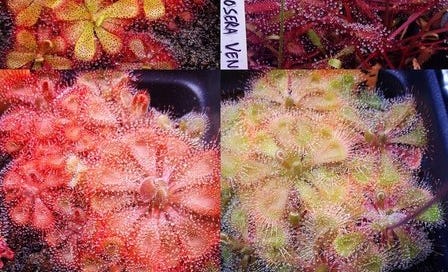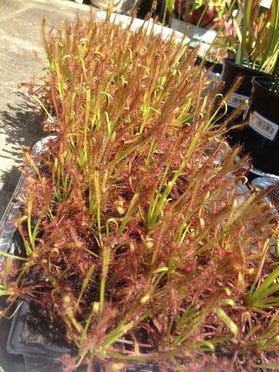GROWING SUBTROPICAL DROSERA
Introduction
Subtropicals are perhaps the largest and most variable group of Drosera. Some, like D. capensis, are very easy to grow and can become weeds in your CP collection if left alone. Others (usually cool-growing South African species) can be quite temperamental if you cannot satisfy their cultural requirements successfully. While highland South American Drosera are technically subtropical, we've placed them in their own separate section due to their more specific care requirements. When reading this care guide, it is important to realize that easier species will have a wider range of tolerable conditions whereas difficult species will not.
Temperature
In general, subtropicals are not very picky in regards to temperature; daytime temperatures within 65 - 80 degrees should be fine for most species. Most of the slightly more difficult species (usually cool-growing South African species like D. slackii) appreciate temperatures that stay below 75 degrees along with a nighttime drop. Other species, like D. madagascariensis, prefer temperatures on the warmer end of the spectrum (but will tolerate a wide range regardless). The takeaway from this is that, while there are general guidelines for temperature, it's important to do research on the specific temperature range that each species will prefer. For example, I grow D. capensis outdoors all summer in NJ where temperatures may occasionally reach up to 100F, and while the plants are clearly happier when we have cooler nights they still grow well all season. In contrast, my D. slackii tends to lose its dew when the ambient temperature exceeds 85F. Prolonged high temperatures will be damaging to all subtropicals, even D. capensis - it may be relatively difficult to fry, but it certainly is not impossible.
Lighting
For most subtropicals, high light is an absolute necessity and will allow you to attain the beautiful coloration that is characteristic of many species. That said, be sure to slowly acclimate plants to brighter light levels, especially if they are fresh arrivals from a grower who gave them far less light than you provide. Both myself and other growers have found through observation that light is the most important factor in dew production for the majority of species.
Humidity
High humidity certainly won't hurt any of these species, as long as you are not forgoing adequate light in favor of humidity. For the more difficult subtropicals, high humidity is a requirement. The more forgiving species won't have much difficulty adjusting to low humidity, though they may not grow as well as they would with optimal conditions. Species like D. capensis, D. venusta, and D. nidiformis, are very tolerant of low humidity and are the best candidates for windowsill growing.
Media and Pot Size
What about pot size? The general rule of thumb is that smaller pots will usually lead to smaller plants. For adult plants, pots around 3" tall are the minimum, though the size of the plant may be restricted. Many subtropical species have very long roots so in most cases larger is better. The best media will depend on your conditions, but you usually can't go wrong with a typical peat/sand mix. For more heat-sensitive species, a top dressing of live sphagnum moss can help to keep the root temperature low. To be completely honest however, most subtropicals care very little for media as long as it is low in nutrients, wet, and acidic. A running joke I hear is that D. capensis will grow in a wet sock - a grower I know recently showed a large quantity of D. capensis seeds on a wet sock to prove this point, and I eagerly await updates (I'm tempted to jump on the bandwagon and do it myself but I'm fairly certain that my parents would be concerned).
Watering, Feeding, and Fertilization
Like nearly all other Drosera, subtropical species aren't tolerant of fertilizer and should be watered with low TDS (total dissolved solids) water. Most species are easily managed in drained pots sitting in deep trays of water. Feeding will dramatically speed up growth though, in most cases, it is not necessary for plants to survive (but if you want your plants to thrive, I recommend feeding them).
Propagation
Propagation of these species tends to be fairly easy. There are certainly exceptions to this, but they tend to be few and far between. Most subtropical Drosera will propagate via root cuttings, leaf cuttings, and self-fertile flowers, D. capensis being a particularly infamous example (if Utricularia bisquamata didn't exist I'm fairly certain that I would instead have nightmares about unattended ripe D. capensis seed pods).
Final Notes
Propagation of these species tends to be fairly easy. There are certainly exceptions to this, but they tend to be few and far between. Most subtropical Drosera will propagate via root cuttings, leaf cuttings, and self-fertile flowers, D. capensis being a particularly infamous example (if Utricularia bisquamata didn't exist I'm fairly certain that I would instead have nightmares about unattended ripe D. capensis seed pods).








